There are many factors that contribute to the failure of urban trees, and many are related to soil issues, such as lack of viable soil, soil volume, and compaction. For my entire career, Landscape Architects have been working with Soil Scientists, Engineers, and Arborists to design urban tree planting techniques to meet specific horticultural, structural, drainage, and use requirements to achieve high performance in city environments.
There is a scientific consensus which much of the industry ignores: compaction does not increase soil quality; in fact, compaction leads to plant death. The science is simple and incontrovertible. If you compact horticultural soils, or alter them to achieve compaction, they become poor — and the plants will suffer because of it. Essentially, if you compact the sand-based structural soil (SBSS), the pavement will be straight, but the tree will suffer. If left non-compacted, the pavement will move, but the trees will be fine (if irrigated).
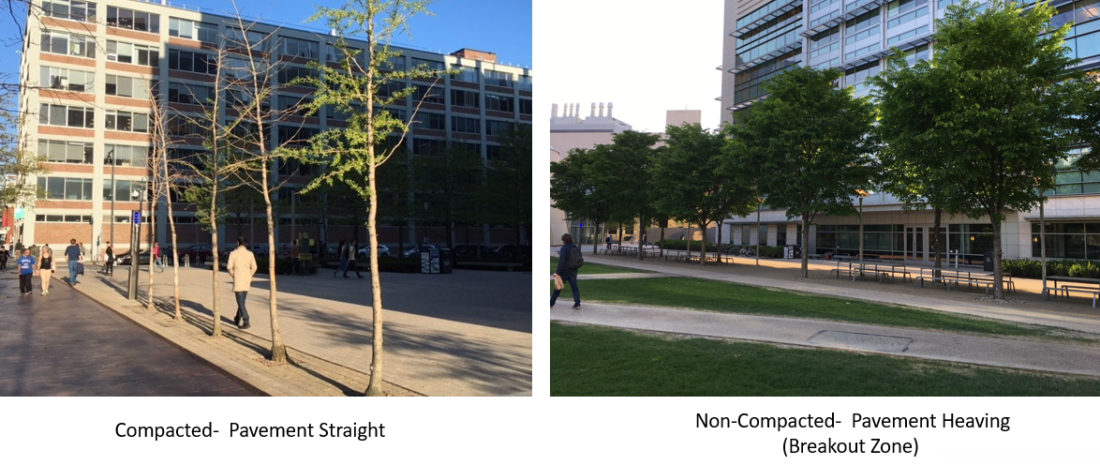
There has been much effort justifying this unsustainable horticultural practice of using sand as a structural soil, because there have been some successes. The first application for SBSS was Amsterdam Tree Soil, which was used in the late 1980s and through the 1990s and codified by Els Couenbourg in the Landscape Below Ground of 1994. The SBSS worked well for her application, due to several factors in Amsterdam. First off, they did not require the soil to be compacted to 95%. Amsterdam is a less litigious society and large tree growth is prioritized, even with some pavement movement. Another factor in its success was that the trees are essentially grown hydroponically. The water table in Amsterdam is controlled by dike, and it must be maintained at discrete levels which allows for a freshwater lens to form over the brackish water. The trees survive by using nutrients from that lens.
Today, Amsterdam tree soil is not used to any degree in Holland due to the fact that it was unable to be replicated in other cities — like Rotterdam — because these areas don’t have the discrete high water table level found in Amsterdam. Additionally, Els told me that the City of Amsterdam has now passed legislation for the 95% compaction for all their city subbases — therefore, it is no longer used anywhere in its original form.
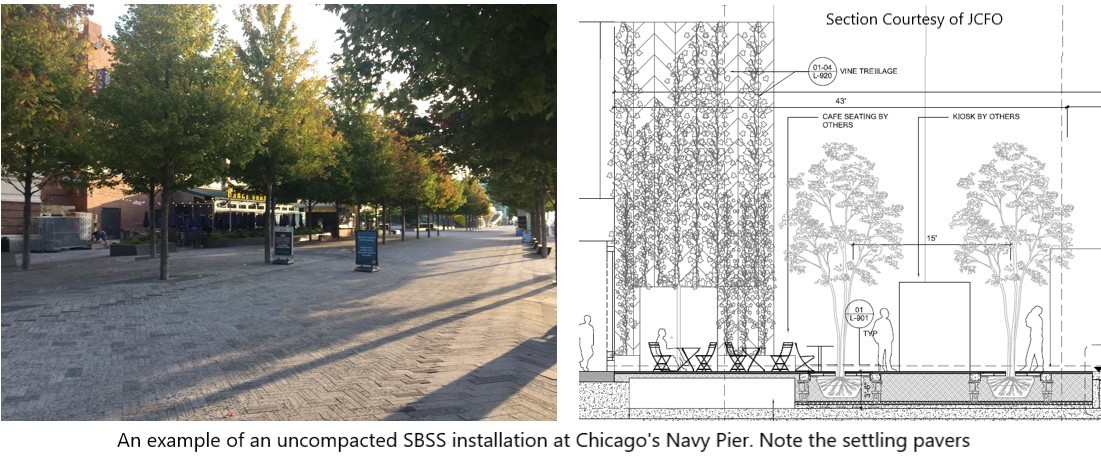
The use of SBSS in the United States is legion. The City of Chicago has an excellent example of a successful SBSS installation at the Navy Pier, a Field Operations, Pine and Swallow project. When walking around the site, it is clear the contractor failed to get compaction: a simple explanation for why the trees are doing so well. The pavement is both subsiding and heaving similar to Els Couenbourg’s data.
Another example touted as an SBSS success story is the World Trade Center in Manhattan, designed by Peter Walker and Partners (PWP). The original design called for pre-cast soil vaults similar in design to the Sky Forest in Tokyo, Japan. Out of budget concerns, they substituted a structural soil for the vaults. The specification was created by Tony Sinkosky formerly of PWP in collaboration with Jeffrey Bruce and Company. It was a lightweight aggregate of small particle size. It was both compacted to 95% and irrigated so there is no movement of the pavements at the site. So, why are they trees doing so well there? The canopies are full and dark green (except in one area where airborne salt comes in from New York bay), and their success is a lesson in unparalleled nursery practice. Each Swamp White Oak (Quercus Bi-Color) was brought in on an individual semi-tractor trailer after having been grown at the nursery in a root ball with a dimension of 12’x12’x6′. This totals over 800 cubic feet of soil per tree. Additionally, a high degree of maintenance is undertaken at the site, particularly in the autumn months before the Memorial’s Reading of the Names ceremony. I laud the way the trees were planted and are maintained in this project — but SBSS has nothing to do with the success of the trees.
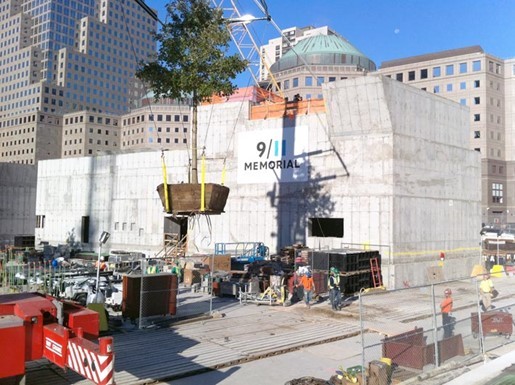
The City of Boston, to my knowledge, has the largest number of SBSS installations of any city — and it has mixed results at best. The street trees along the entire Rose Kennedy Greenway were implemented with SBSS, and most of the trees there are in decline or have been replaced and derive little benefit from the medium. The Rose Kennedy Greenway Conservatory has a robust street tree replacement program. Note these trees are not irrigated, contrary to the research.
There are some carefully studied SBSS installations at the Boston Four Seasons Hotel and the Central Wharf Plaza, and these two have been touted as success stories for the technique. They were highlighted in the “Great Soil Debate” (organized in the 2000s-2010s by Chris Moyle, FASLA (deceased) of Reed Hildebrand). They were also highlighted in the “Boston Tree Party” the last time the ASLA show was in that city in 2014. As a result of these efforts, Jim Urban was able to survey the trees of these sites and on the Rose Kennedy Greenway noting interim growth because the DBH at planting was known. His findings are as follows: The best way to plant trees is in open planters, the second best is suspended pavement, and the worst method is sand-based structural soil, according to DBH growth. Based on this data, the trees at the Four Seasons and Central Wharf would be the exceptions.
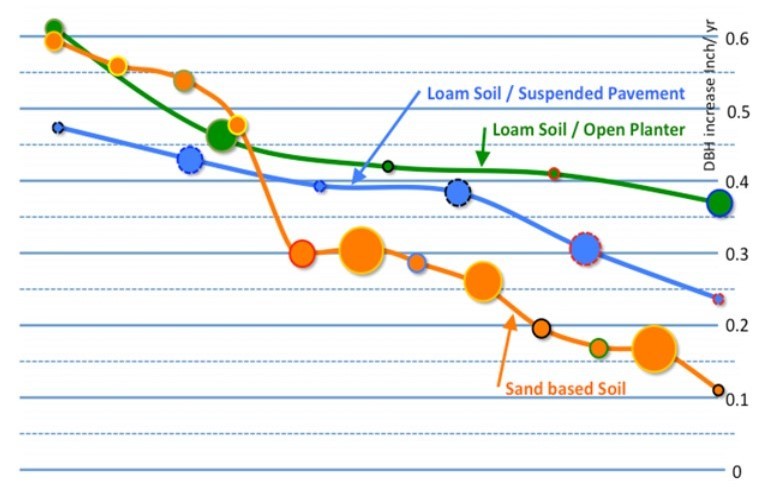
Urban’s evaluation and circumstances prove otherwise. At the Four Seasons, the Lindens in open planters are doing well, but those in small tree openings have not fared well. I confirmed this in June of 2022. All the trees at the hotel are pruned annually so they don’t get big, and they are rigorously maintained at the entrance to a high-end mall attached to the hotel. Central Wharf Square is similar in that it is at the entrance to the New England Aquarium and has a high degree of maintenance. The shared rooting volumes there are a good design, but despite this there is competitive dieback, and less DBH growth in the structural-soil trees. Both installations share the fact that the trees in SBSS are significantly underperforming the adjacent trees in the open planters. In reality the SBSS is not a quality soil at either site.
The prime example of the variability of SBSS can be found at the Koch Center at the Massachusetts Institute of Technology in Cambridge. Designed by Reed Hilderbrand Associates and completed in 2011, it is one of MIT’s largest courtyards and streetscapes. Envisioned as a mix of green space and connective paths, some of the trees are doing well and others are a catastrophic failure. The difference is compaction. The plaza area to the north of the building is exhibiting pavement upheaval and settlement showing that the 90+% compaction was not achieved, and the roots are probably accessing an open lawn area. No surprise that the trees look great. On the Main Street side, the Koch Center’s pavement is absolutely straight, and all the Ginkgoes and Pin Oaks are dead or dying, and have been replaced I think this is because 95% proctor density was achieved similar to what Els Couenbourg found. The medium lacks good air-moisture relationships and has poor structure and texture — and on Main Street, it is poorly drained-the ultimate reason for trees’ death.
Both sites are chronicled and studied prior to the “Boston Tree Party” at the 2014 ASLA show in Boston and were presented as a paper on how to plant trees. Much about the Koch Center site is understood, including why the trees died, as confirmed in a post-mortem conducted by MIT itself. Both Reed Hillebrand and MIT are currently re-evaluating their soil strategies.
Further proof of how necessary irrigation is to the success of SBSS can be seen at the project Vassar Street in Cambridge, MA, by Carol R. Johnson Associates (now IBI Group). It was also featured in the Boston Tree Party Tour. It is a multiblock streetscape installed from 2006-2009. According to the designer, after a few years, irrigation was not used on the trees, and all of them began to fail with disastrous results. The irrigation was subsequently fixed or began to be used. Many of the trees miraculously recovered. Walking the street from one end to the other you can easily discern where the irrigation was successfully reinstated since most of the trees to the southwest are in horrible condition and the trees to the northwest have recovered from the lack of water. A better design might have been to create “breakout zones” so the trees could access the adjacent MIT Briggs Playing Field which has grass and irrigation of its own.
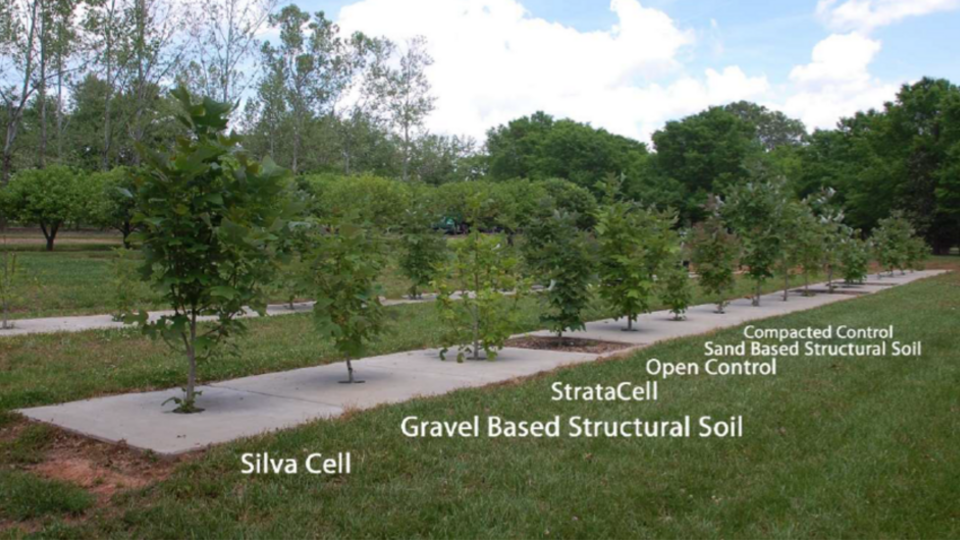
Fortunately, there are data that confirms the empirical studies to date on sand-based structural soil. Recently completed by Dr. E. Thomas Smiley, Mr. James Urban, FASLA, and Dr. Kelby Fite, the study — “Comparison of Soil Treatments Under Concrete Pavement” — was conducted by at the Bartlett Tree Research Laboratory in Charlotte, North Carolina. It examined variations of the two main approaches that have been developed to provide rooting space for trees in urban areas: supported pavement and structural growing media.
Established in 2014, the research examined six variations of structural media: DeepRoot’s Silva Cell system, SBSS, gravel-based structural soil (GBSS), another structural load-bearing module (Strata Cell), an open control, and a compacted control. Silva Cells significantly outperformed all the structural soil treatments in height, weight, DBH, color, root mass, and root extension. SBSS underperformed versus the compacted control. The research in this study is clear: high-quality, loamy soils in load-bearing modules outperform structural soils. The results of this science should render the “Great Soil Debate” moot. For municipalities looking to unlock the well-known benefit of trees, they should not only require soil volume standards, but soil quality as well. What good is soil volume if the planting soil quality is so poor that it fails to be an improvement over the soils you were replacing? The study quantifies what we have always know empirically: Trees grow best in high-quality, lightly compacted soils — and a lot of it.

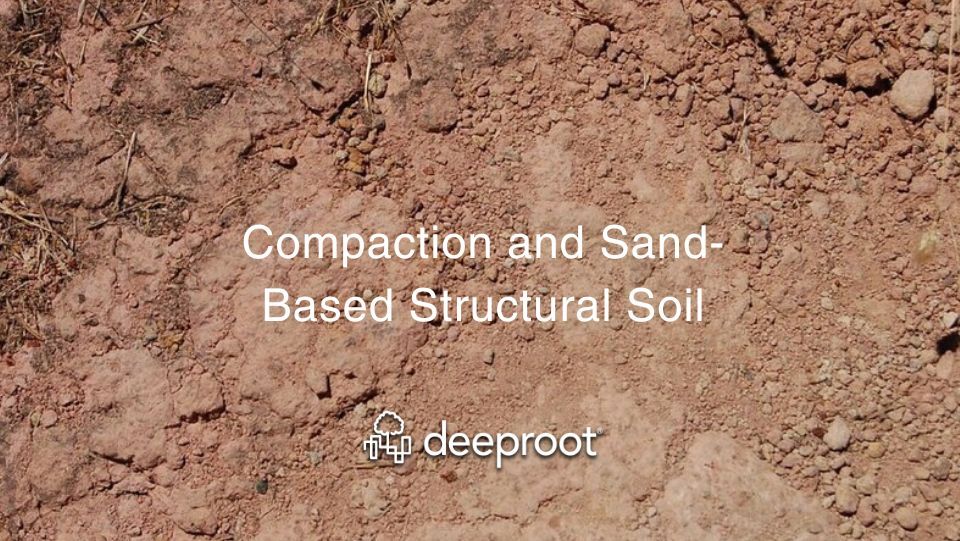




Al,
Thanks for this summary of many SBSS installations.
Question: Am I reading this correctly that proper consolidation of SBSS to 90% should PREVENT root-pavement heaving? I have seen settling (and poor drainage) related to irregular consolidation, and also heaving related to over-compaction. But have also seen drainage problems with sand based turf compacted in the 90-92% range, and wonder if it shouldn’t be more like 85%.
Hi, Howard,
Thanks for your comment. Here is Al’s response:
Since the sand and the crushed aggregate base for the paving (if used) are compacted to 95%, they will act like any other sub base. These particular cases you mention are typical of many street tree openings, sand-based structural soil applications included. Regarding the drainage issue, this is exactly the reason why the ginkgoes died on Main Street in Cambridge in front of the MIT Koch center.
Howard & Jacob i would add that given the tree has limited growth in compacted SBSS, the issue of heaving pavement would be next to nil, because the tree would enter maturity shortly after it gets out of transplant shock